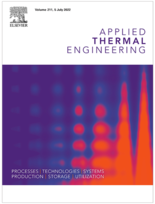
Numerical investigation of CO2 behavior in the internal heat exchanger under variable boundary conditions of the transcritical refrigeration system
Author(s) : ITUNA-YUDONAGO J. F., BELMAN-FLORES J. M., ELIZALDE-BLANCAS F., et al.
Type of article: Article
Summary
The study is focused on the impact of the variation in temperature and mass flow at the inlet boundary of both hot and cold streams, on the CO2 thermophysical properties, the heat transfer rate and thermal effectiveness of an internal heat exchanger, and therefore the overall coefficient of performance of a transcritical refrigeration system. Five different cases of boundary conditions based on temperature and mass flow rate are numerically analyzed using the commercial Computational Fluid Dynamics software Fluent. The governing equations are discretized by using the finite volume method. Numerical results were successfully compared with empirical correlations for the Nusselt number. Additionally, the effect of mesh density on the numerical results was analyzed. The results showed that the hot stream is the most affected by the transient change due to the supercritical operating conditions. The change in the mass flow rate causes the decrease in the heat transfer rate and the thermal effectiveness at the beginning of the system operation. The transient period of both heat transfer rate and the thermal effectiveness extends much more when the inlet temperature is low. The high inlet temperature allows the internal heat exchanger to be more efficient. The transient behavior of the coefficient of performance is inversely proportional to that of the internal heat exchanger thermal effectiveness.
Details
- Original title: Numerical investigation of CO2 behavior in the internal heat exchanger under variable boundary conditions of the transcritical refrigeration system
- Record ID : 30021184
- Languages: English
- Source: Applied Thermal Engineering - vol. 115
- Publication date: 2017/03/25
- DOI: http://dx.doi.org/10.1016/j.applthermaleng.2017.01.042
Links
See other articles in this issue (31)
See the source
Indexing
-
A generalized moving-boundary algorithm to pred...
- Author(s) : BAHMAN A. A., ZIVIANI D., GROLL E. A.
- Date : 2020/10
- Languages : English
- Source: International Journal of Refrigeration - Revue Internationale du Froid - vol. 118
- Formats : PDF
View record
-
Heat transfer in horizontal ground heat exchang...
- Author(s) : KUPIEC K., LARWA B., GWADERA M.
- Date : 2015/01/22
- Languages : English
- Source: Applied Thermal Engineering - vol. 75
View record
-
Numerical simulation and experimental validatio...
- Author(s) : RIGOLA J., ABLANQUE N., PÉREZ-SEGARRA C. D., et al.
- Date : 2010/06
- Languages : English
- Source: International Journal of Refrigeration - Revue Internationale du Froid - vol. 33 - n. 4
- Formats : PDF
View record
-
Development of a new forced convection heat tra...
- Author(s) : LI H., KRUIZENGA A., ANDERSON M., et al.
- Date : 2011/12
- Languages : English
- Source: International Journal of thermal Sciences - vol. 50 - n. 12
View record
-
Experimental and numerical study of convection ...
- Author(s) : JIANG P. X., ZHAO C. R., SHI R. F., et al.
- Date : 2009/10
- Languages : English
- Source: International Journal of Heat and Mass Transfer - vol. 52 - n. 21-22
View record
